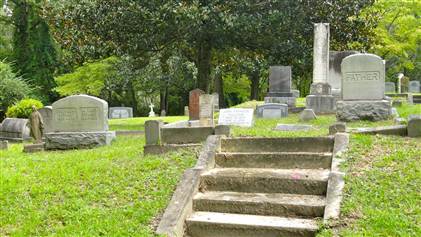Hill Crest Cemetery
Holly Springs, MS, 38635 US / MS
Hill Crest Cemetery
Location Description
Hillcrest Cemetery is a historic cemetery in Holly Springs, Mississippi, United States. Established in 1837, it is known as the "Little Arlington of the South." It contains the burials of five Confederate generals. The cemetery was established in 1837, when William S. Randolph, an early settler of Holly Springs, donated the land. The railings were designed by the Jones, McElwain and Company Iron Foundry prior to the Civil War. It is known as the "Little Arlington of the South" in allusion to the Arlington National Cemetery near Washington, D.C.. Notable burials include five generals of the Confederate States Army: Samuel Benton, Winfield S. Featherston, Daniel Govan, Edward Walthall, and Absolom M. West. Other notable burials include Wall Doxey, Benjamin D. Nabers, Hiram Rhodes Revels, and James F. Trotter. Also buried there are painter Kate Freeman Clark and the wife and son of Alamo defender Micajah Autry. The cemetery was vandalized in 1980. It has been listed on the National Register of Historic Places since June 28, 1982. Hill Crest Cemetery is one of great gems of Holly Springs and one of the finest historic cemeteries in north Mississippi, though the local government has not always treated it as such. Hill Crest Cemetery was first formed in 1845, when R. H. Byrne donated the land of the cemetery to the city of Holly Springs. However, these grounds were used as a cemetery even before the city took control of the land, as there are several early graves which date to 1838. This original cemetery plot is located along Center Street (the old Oxford Road), and many of the oldest tombstones in the cemetery can still be found there today. In 1904, the cemetery expanded north, after Dr. John Burton deeded a lot to the city which had earlier been used as a baseball field. This part of the cemetery fronts Elder Street, which is also where the beautiful iron gates, donated by the Wynne family, can be found. For many decades the cemetery was simply known as the Town Cemetery. It received its name “Hill Crest” in 1905, by Mrs. W. A. Anderson, after attending the funeral of Hindman Doxey. Many of the greatest citizens in Holly Springs and Marshall County are buried in Hill Crest, including founding fathers, war heroes, local, state and federal politicians and other figures. Hill Crest Cemetery contains the bodies of many unknown soldiers who died in the Civil War, along with the remains of six Confederate generals. In addition, there are two Confederate monuments in the Cemetery: the Monument to the Confederate Dead, erected in 1874-1876 (the central shaft was not erected until 1901), and a newer monument to the southeast, erected by the Sons of the Confederacy in 1890. The cemetery also contains a mass burial ground for victims of the Yellow Fever Epidemic of 1878, though this mass grave is currently unmarked. In addition, many of the more notable victims of the Fever are buried in their family plots. There are also two large monuments dedicated to certain victims of the Fever: the Mississippi Press Association monument, dedicated to the W. J. L. Holland, Kinloch Falconer and other reporters who died in the Fever, and the monument to Father Oberti and the Catholic nuns who died administering to the sick and dying during the epidemic. For many years, James “Bud” Holbrook was the groundskeeper of Hill Crest who earned the respect of the townspeople by perfectly maintaining the grounds and monuments. In the 21st century, the foremost authority on Hill Crest Cemetery is Bobby Mitchell, who has authored a book on the cemetery and has plotted nearly every lot and historic grave in the cemetery. Hill Crest Cemetery was listed on our 2016 list of the Top Ten Most Endangered Historic Properties in Holly Springs. Hill Crest Cemetery has suffered greatly over the many years from vandals, negligent groundskeepers and inept city government. Today, numerous monuments and iron fences are destroyed,
Location Category
- CEMETERIES - [general]
- CEMETERIES - Rural / Private
Architecture Style
- 1800s / Civil War
- 1920s - 1930s
Disclaimer: All data, information, and maps are provided "as is" without warranty or any representation of accuracy, timeliness or completeness. The content of the information is solely dependent on the location owner/contact and no warranties, express or implied, as to the use of the information are obtained here. The requestor acknowledges and accepts all limitations, including the fact that the data, information, and maps are dynamic and in a constant state of maintenance, correction and update.













































































































































































































































































